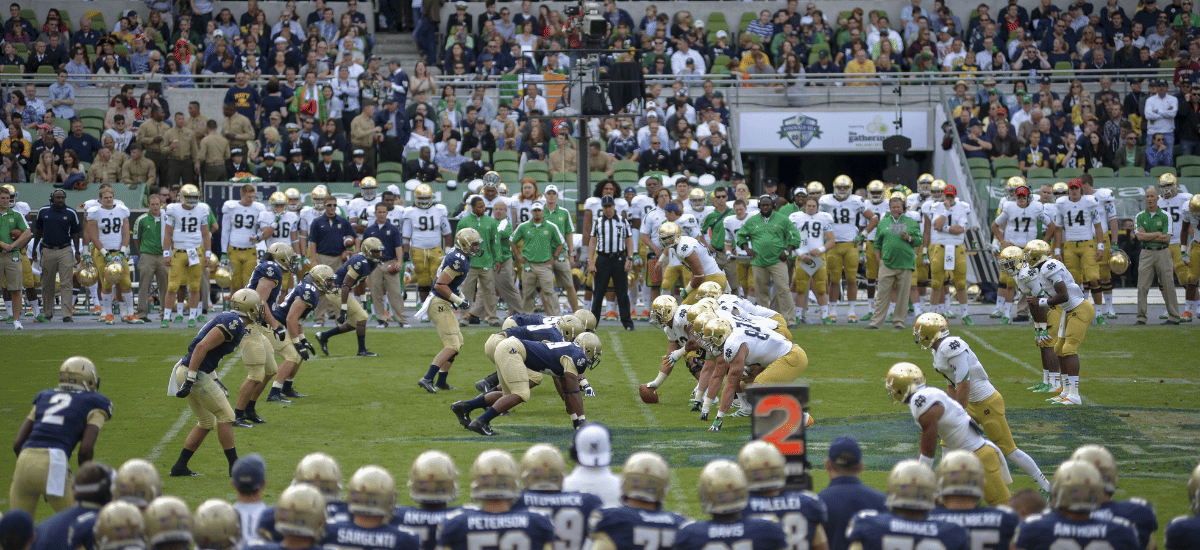Don’t worry if you can’t tell a touchdown from a home run; by the end of this guide, you’ll be spiking your knowledge in the end zone rather than fumbling through the rules!
The National Football League (NFL) is a powerhouse of American sports, drawing millions of fans every season with its thrilling action and intense competition. But if you’re new to the game, the complex rules and strategies can feel overwhelming. Don’t worry—we’ve got you covered!
This guide will break down the basic NFL football rules in a way that’s easy to understand, so you can enjoy the game like a seasoned fan.
What Is NFL Football?
At its core, NFL football is a team sport played on a rectangular field where two teams compete to score points by advancing the ball into the opponent’s end zone. Sounds simple, right? The real fun lies in the details: the strategy, the teamwork, and the electrifying plays that make each game unique.
The Basics Of An NFL Game
1. The objective of the game
The main goal in football is to score more points than the opposing team. Points can be scored in various ways:
- Touchdown (6 points): Advancing the ball into the opposing team’s end zone.
- Extra Point (1 point) or Two-Point Conversion (2 points): Scored after a touchdown.
- Field Goal (3 points): Kicking the ball through the opponent’s goalposts.
- Safety (2 points): Awarded to the defense if they tackle an opponent in their own end zone.
Each team strives to control the ball, gain yards, and execute their strategy to outsmart the opposing team.
2. The field and key markings
An NFL field is 100 yards long and 53.3 yards wide, with an additional 10-yard end zone on each side. Here’s what you need to know about the markings:
- Hash marks: These small lines help position the ball for plays.
- Yard lines: The field is divided into increments of 5 yards, marked with lines and numbers to indicate progress.
- Goal line: This is the line that must be crossed to score a touchdown.
- Sidelines and end lines: These mark the boundaries of the field. Stepping out of bounds stops the play.
3. Game structure
NFL games are divided into four quarters of 15 minutes each, with a halftime break after the second quarter. The game clock stops frequently, meaning a full game usually lasts about three hours.
If the score is tied at the end of regulation, the game goes into overtime:
- Overtime consists of a 10-minute period where the first team to score a touchdown wins.
- If no one scores a touchdown, a field goal or other scoring play can decide the game.
The YouTube video given below breaks down the game into easily understandable parts, covering football rules, positions, plays, penalties, and how to score. It serves as an excellent resource for beginners wanting to understand American Football comprehensively.
Now that you’ve wrapped your head around the game’s layout, let’s tackle the players and their positions so you can see who does what on the field.
Understanding these fundamental aspects is key, not just for enjoying the game more, but also for making informed decisions if you’re considering participating in activities like sports betting on platforms such as DGbet.
Players And Positions
Each team fields 11 players on the field at a time. Understanding their roles will enhance your appreciation for the game:
Offensive positions
- Quarterback (QB): The leader of the offense, responsible for throwing passes or handing the ball off.
- Running Back (RB): The ball carrier, specializing in running through defensive lines.
- Wide Receiver (WR): Catches passes from the quarterback.
- Tight End (TE): A versatile player who can block or catch passes.
- Offensive Line (OL): Includes tackles, guards, and a center, whose job is to block defenders and protect the quarterback.
Defensive positions
- Defensive Line (DL): Linemen who try to stop the run and pressure the quarterback.
- Linebackers (LB): These players are a mix of defenders who can tackle, cover receivers, and rush the passer.
- Cornerbacks (CB) and Safeties (S): Defensive backs responsible for preventing completed passes and intercepting the ball.
Special teams
This unit handles plays like kickoffs, punts, and field goal attempts. Key players include:
- Kicker (K): Responsible for kickoffs, extra points, and field goals.
- Punter (P): Kicks the ball downfield when the team cannot advance.
- Returners (KR/PR): Catch and return kickoffs or punts.
NFL Game Clock Rules
Understanding the game clock is essential for following NFL games, as time management heavily influences strategy and outcomes. Here’s a concise guide:
- Game Clock Basics: Four 15-minute quarters with stoppages; actual game time stretches to ~3 hours.
- When the Clock Stops:
- Incomplete passes.
- Ball carrier out of bounds.
- Timeouts (3 per team per half).
- Change of possession (punts, interceptions, turnovers).
- Scoring plays (touchdowns, field goals, safeties).
- Penalties and the two-minute warning (in the 2nd and 4th quarters).
- Play Clock: Offense has 40 seconds (or 25 in certain cases) to snap the ball or face a 5-yard penalty for delay of game.
- Two-Minute Warning: A built-in pause near the end of each half for high-stakes strategy adjustments.
- Overtime Clock Rules:
- Regular season: 10-minute sudden death; ties allowed.
- Playoffs: Full 15-minute periods until a winner is determined.
- Strategic Clock Use:
- Offense uses running plays to keep the clock moving.
- Defense may force out-of-bounds plays to conserve time.
- Timeouts and spiking the ball help stop the clock during critical moments.
Mastering these rules enhances your understanding of the game and the strategies teams use to control time in pivotal moments.
Key Rules To Know In NFL Football
Understanding the essential rules of NFL football helps beginners follow the action on the field and appreciate the strategic depth of the game. Here are the most important rules to know:
1. The forward pass
- A quarterback can throw the ball forward only once per play, and it must be from behind the line of scrimmage.
- Once the ball crosses the line of scrimmage, any subsequent passes must be lateral or backward.
2. The line of scrimmage
- The line of scrimmage is the imaginary line where the ball is placed at the start of a play.
- Both teams must remain on their respective sides of this line until the play begins.
3. Four downs to gain 10 yards
- The offense has four attempts (downs) to advance the ball at least 10 yards.
- If successful, they are awarded a new set of downs. If they fail, the opposing team gains possession.
4. Tackling
- Defenders aim to stop the ball carrier by tackling them to the ground. A tackle ends the play.
- Tackling too roughly or targeting a player’s head can result in penalties, such as unnecessary roughness or targeting.
5. Turnovers
- The ball changes possession in three main ways:
- Interception: A defensive player catches a forward pass intended for an offensive player.
- Fumble: The ball carrier drops the ball, allowing either team to recover it.
- Turnover on Downs: The offense fails to gain 10 yards in four downs.
6. Scoring plays
- Teams score points in various ways:
- Touchdown (6 points): When the ball is carried or caught in the opposing team’s end zone.
- Field Goal (3 points): Kicking the ball through the uprights of the goalpost.
- Extra Point (1 point): A successful kick after a touchdown.
- Two-Point Conversion (2 points): Running or passing the ball into the end zone after a touchdown.
- Safety (2 points): The defense tackles an offensive player with the ball in their own end zone.
7. Penalties
- Referees enforce rules by penalizing teams for infractions. Common penalties include:
- Offside: A player crosses the line of scrimmage before the ball is snapped (5-yard penalty).
- Holding: Illegally grabbing an opponent to prevent movement (10-yard penalty).
- Pass Interference: Illegally obstructing a receiver’s ability to catch the ball (yardage varies).
- Delay of Game: Failing to snap the ball before the play clock runs out (5-yard penalty).
8. Incomplete pass
- If a forward pass is dropped or hits the ground before being caught, it’s considered an incomplete pass, and the play ends immediately.
9. Out of bounds
- A play ends when a player steps out of bounds, causing the clock to stop temporarily.
10. Kicking rules
- Kicks occur during punts, kickoffs, field goals, and extra points.
- Kickoffs start each half and follow a scoring play. The ball is kicked to the opposing team, who then attempts to return it for as many yards as possible.
11. Play clock
- Teams must snap the ball within 40 seconds (or 25 seconds in some situations) to avoid a delay of game penalty.
Knowing the ins and outs of the game helps, whether you’re on the sidelines cheering or partaking in responsible betting through secure platforms like DGbet.
Common NFL Terms For Beginners
If you’re new to the NFL, the terminology can sometimes feel like a foreign language. Understanding the basic terms and phrases used in football is essential for following the game and enjoying it to its fullest. Here’s a quick glossary of common NFL terms that every beginner should know to sound like a seasoned fan in no time!
- Snap: The act of the center passing the ball to the quarterback to start a play.
- Sack: When a defensive player tackles the quarterback behind the line of scrimmage.
- Pick Six: An interception returned by the defense for a touchdown.
- Huddle: A team gathering to discuss strategy before a play.
Important Tips For Beginners
- Learn the lingo: Familiarize yourself with basic terms and player positions.
- Follow a team: Rooting for a specific team makes games more engaging.
- Watch highlights: Review key moments from games to better understand the action.
- Ask questions: Don’t hesitate to seek help from seasoned fans—they’ll love explaining the game!
Conclusion
NFL football might seem complex at first, but once you grasp the basics, you’ll find it’s an electrifying and strategic sport. From the camaraderie of tailgating to the thrill of a fourth-quarter comeback, there’s something for everyone to enjoy.
So, grab a jersey, pick your favorite team, and get ready to cheer—you’re about to dive into one of the most exciting sports in the world!






